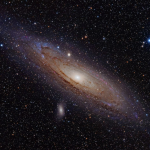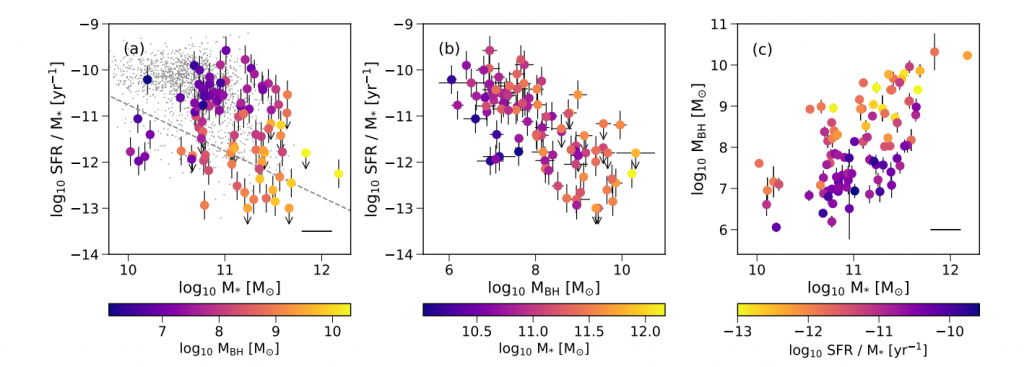
The M31 galaxy, an example of a partially quiescent galaxy, where we argue that feedback from AGN incompletely suppresses star formation.
AGN feedback efficiency is a gradual function of supermassive black hole mass and stellar mass. This empirical mapping of the effects of AGN feedback from Bryan Terrazas and collaborators (ApJ, in press) both tests galaxy formation models and highlights a population of galaxies with partially suppressed star formation – galaxies like M31 or M81 that we term partially quiescent.
One of the ‘grand challenges’ of galaxy evolution is to better understand the drivers of a quiescence – a lack of star formation in galaxies. Early cosmological simulations predicted that all galaxies in the centers of their dark matter halos (‘central’ galaxies) should have star formation, governed by the cooling rate of gas in halos and regulated by feedback from massive stars and supernovae. Yet, many galaxies – typically those with high central stellar densities, high velocity dispersion, often high stellar mass, and large supermassive black holes – lack star formation. Many physical processes are possibly relevant – e.g., changes in cooling efficiency of halos as a function of mass, changes in star formation efficiency as a function of gravitational potential, the injection of large amounts of energy from supermassive black holes (AGN feedback).
In an earlier paper, we used a sample of central galaxies with directly measured black hole masses to show that quiescent galaxies have a much larger supermassive black hole than star-forming galaxies of the same stellar mass, in excellent accord with galaxy formation models where AGN feedback is responsible for suppressing star formation in galaxies.

Projections of the sSFR–MBH–M∗ data cube with our sample of 91 central galaxies with directly measured black hole masses, stellar masses and specific star formation rates denoted by colored points. (a) sSFR as a function of M∗. The gray data points indicate a sample of local galaxies to show the star forming main sequence. The dashed line indicates the boundary below which the sample is no longer complete; (b) sSFR as a function of MBH; (c) MBH as a function of M∗. Color gradients indicate the values for the axis not shown. The lines at the bottom right of (a) and (c) indicate the errors on M∗. Figure 1 of Terrazas et al. 2017.
In this paper, we asked a crucial follow-up question – is the shut-off of star formation all or nothing, or is partial suppression of star formation possible? We find that star formation rate is a continuous function of supermassive black hole mass. Galaxies with low-mass supermassive black holes (like our Milky Way) have typical star formation rates, galaxies with intermediate mass black holes (like M31 or M81) have somewhat suppressed star formation, whereas galaxies with huge supermassive black holes (like M87) have dramatically suppressed star formation. We call galaxies with intermediate black hole mass partially quiescent (in other works these have been dubbed ‘green valley’ galaxies, as they often have colors intermediate between the blue star forming galaxies and red quiescent galaxies). These galaxies are not uncommon, and given that many of them (like M31 or M81) have long-lived stable star forming disks, we suggest that these are in a near-equilibrium state in which star formation is incompletely suppressed by AGN feedback. Interestingly, no galaxy formation model correctly reproduces the observed trends in detail, offering a new and important test of their AGN feedback implementations.

